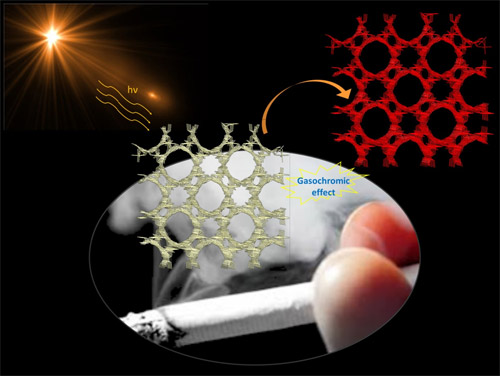 Scientists at the Institute of Nano Science & Technology, Mohali an autonomous institute of Department of Science and Technology, Government of India have found a method of colorimetric sensing of nicotine from cigarette smoke at room temperature in the presence of sunlight and tungsten light even when it is present at extremely low concentration.
Scientists at the Institute of Nano Science & Technology, Mohali an autonomous institute of Department of Science and Technology, Government of India have found a method of colorimetric sensing of nicotine from cigarette smoke at room temperature in the presence of sunlight and tungsten light even when it is present at extremely low concentration.
The method can determine the concentration of the nicotine in a solution with the aid of a color reagent, which is a Zn based Metal-organic nanotubes (MONTs), even in exceedingly low detection limits. This work funded by SERB-DST can help check on air quality in public places such as schools, hospitals, aircraft, and other non-smoking zones and prevent exposure to carcinogenic nicotine through second-hand smoking. The work has been published in the journal ACS Materials Letters.
The first of its kind, visible light assisted, fast, easy, naked eye-specific method developed by Dr. Monika Singh and her team can determine the concentration of nicotine from cigarette smoke up to a detection limit of around 23.3 µM in just 55 seconds.
The researchers synthesised Metal-organic nanotubes (MONTs) that comprise of tubular channels of a particular size, which offers the passage of specific and selective organic molecules. Zinc was used as metal center as zinc-based MOFs possess photoluminescent properties and are also generally white in colour. So, any analyte which could pass through the channels of MONT and coordinate with Zn metal site will cause a drastic and detectable colour change in MONT. Since cigarette smoke contains more than 4000 organic moieties and gases, they introduced cigarette smoke to the MONT to see if any detectable change is observed or not. To their surprise, white coloured MONT changed to dark pink in colour. The material is also reusable upto three cycles.
When this MONT was exposed to cigarette smoke in home-made smoke chamber in the presence of sunlight or 50 Watt tungsten bulb, the color changed from light yellow to dark pink in approximately 20 to 50 sec. To ascertain that the chromic effect is indeed due to the sensing of nicotine, it was first exposed to dilute ethanolic solution of nicotine (5mM), and the experiment repeated in the presence of sunlight or 50 Watt tungsten bulb. Through the repetition of the experiment with different forms of nicotine, the group established the high selectivity and specificity of MONT for nicotine.
Sensing of nicotine has been explored in the recent past, mostly through electrochemical methods, carbon-based sensors. In contrast, colorimetric sensing is fast and easy because color change can be easily detected. The chemical and thermal stability of MONT and quick and easy detection of nicotine in the air gives great prospects as a sensor for practical environmental applications.
Publication: Deepika Rani, Kuldip K Bhasin, and Monika Singh, ACS Materials Letters, 2020, 2, 9-14.
For more details, Dr. Monika Singh (monika[at]inst[dot]ac[dot]in, 0172-2210075 (ext. 322)) can be contacted.






























